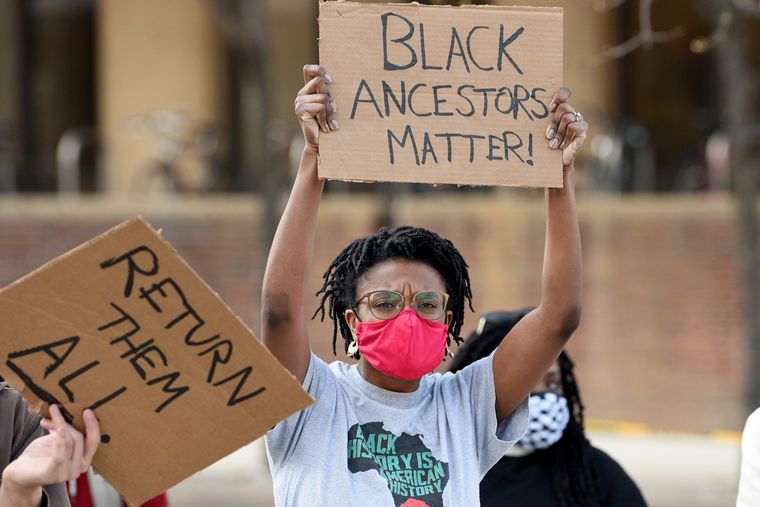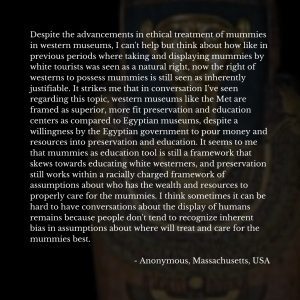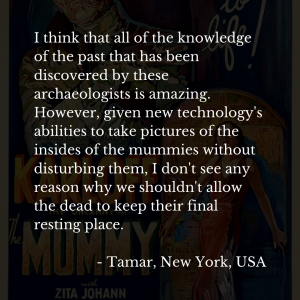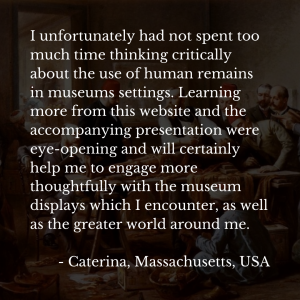The Future
The debate over human remains and their role in the museum space has been in the background of many institutional critiques for years, having been waged over the past several decades amidst cultural overhauls in pursuit of a more ethical philosophy of archaeological display. Scholars of the museum world have repeatedly asked: is it ethical to display the remains of those who have died? What benefit is there to the display of human remains? And, importantly, whose remains deserve to remain private?
Whose Remains are Private?
Human remains have resided in archives, exhibits, and hidden museum backrooms for centuries, fascinating the living with their connection to the past. But over the many years, some have questioned whether or not this is where remains belong. The existence of death and decay garners respect and reverence from countless cultures around the world, who see the exhibition of the deceased as an immoral, exploitative practice. In more recent years, museums internationally have been made aware of this dissent through countless repatriation claims, or requests for a museum to return the human remains of a person in their collection to their country or region of origin, usually for proper burial.
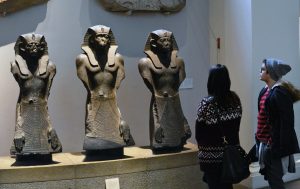
Many institutions have chosen to respond to these claims on a “case-by-case basis,” reviewing requests for repatriation one at a time in their full context, sometimes choosing to return them, but more often electing to keep the deceased within their collection. Several museums have issued statements on their handling of human remains in response to pressure from academia and the public, outlining their philosophies and protocols for the preservation, storage, and display of bodies. A post by British Museum ancient Near East curator and archaeologist Alexandra Fletcher discusses her institution’s philosophy, stating, “display should be done with careful thought. There is no justification for the voyeuristic display of human remains simply as objects of morbid curiosity.” Yet who decides where the line between respectful and voyeuristic lies? How might personal or cultural beliefs affect a curator’s choice to display or repatriate a deceased person?
Asserting a Social Order
It does not take long when examining the history of the display of human remains to notice the practice’s ties to asserting dominant cultural norms, especially in terms of racism, xenophobia, and ableism. The display of deceased bodies in the museum space has frequently been used as a tool of oppression throughout history, reaching back to the original cabinets of curiosities of the sixteenth and seventeenth centuries, where European aristocrats exhibited the bodies of the “savage” Indigenous Americans. The display of mummies is also entangled in the history of racism and xenophobia, as white academics utilized mummified bodies in their efforts to peddle concepts of scientific racism against African people. The added layer of orientalism present in events such as mummy unwrapping parties further demonstrates the fraught history of mummies as objects of social stratification.
For many, this pain is still present in exhibitions today. Museum administrator Ben Garcia unpacks the unique difficulties and opportunities of studying the display of human remains in his article “For Whom the Human Remains?:”
“For those interested in the social-justice aspects of museum work, working within the nuanced and foggy realm of questions related to human remains is compelling and very challenging. This is a terrain of emotion- and ideology-fueled certainty. This is terrain where linear and narrative ways of thinking collide—where those who hold these collections subscribe to Western scientific notions and are challenged by thought systems that do not hold objectivity as the highest ideal, or even as an ideal at all; where resentment, frustration, anger, guilt, and profound grief all lie close to the surface. And where the bluntest possible tools—law and policy and regulation—are wielded on both sides as if they can address what is really at issue: historical trauma and the half-life of violence.”
– Ben Garcia, “For Whom the Human Remains?,” 74-75.
Scientific Utility
For all of the difficulties that the display of human remains poses, there are some commonly accepted advantages to their research. In truth, most participants of discussions regarding human remains agree that there are indeed benefits to exhuming deceased bodies, at least temporarily, for scientific research. Especially in the case of studying ancient societies, which often lack surviving, legible historical material, studying the human remains of a particular era can offer numerous insights into the life and times of ancient peoples. Egyptologist Paula Veiga outlines this in her article “Studying Mummies and Human Remains: Some Current Developments and Issues:”
“Through advanced forensic techniques we can learn about: ancient diet; diseases; causes of death (such as plagues infesting crops); climate changes and famines (as shown in bone markers); hemorrhagic processes from trauma; genetic disorders, as shown in ancient DNA fevers caused by bacteria; animals bites and stings; inflammation samples; hair lice; blindness caused by sand, wind or stone quarrying; water worms in the Nile River; and battles.”
– Paula Veiga, “Studying Mummies and Human Remains: Some Current Developments and Issues,” 6.
Where Do We Go From Here?
Though much of the history of the display of mummies and human remains offers troubling anecdotes of dehumanization and exploitation, there have been significant strides in the last several decades. Major museums around the world now publish their philosophies and protocols for handling human remains publically. Additionally, the climate around repatriation requests, though nowhere near perfect, is much more accepting and understanding of cultural differences and ethical considerations than it was several decades ago. Legal actions, such as the implementation of the Native American Graves Protection and Repatriation Act in the United States and the Human Tissue Act of 2004, have helped regulate the handling and transfer of human remains in the cultural and economic sectors, allowing for more ethical environments.

That being said, there is still an active dissenting voice against the collection and display of human remains in museums. Most recently, protestors at the Penn Museum in Philadelphia have demanded the museum return the remains of a victim of the 1985 MOVE bombing to their surviving family. Protests such as this show how debates surrounding human remains continue today, and will likely continue for many years to come.
Contribute to the Conversation
The debate around the display of mummies and human remains has existed for decades, and will likely continue for decades more. If you’d like to contribute your thoughts to the conversation, click the link below to share your opinions, anecdotes, thoughts, or hopes for the future pertaining to the collection and display of mummies or human remains. Responses will be incorporated into the slideshow below.
Share Your Thoughts
Read What Others Think
